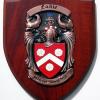-
Posts
1,867 -
Joined
-
Last visited
Reputation Activity
-
 Chuck Seiler reacted to tkay11 in 18th and early 19th Century cutter models
Chuck Seiler reacted to tkay11 in 18th and early 19th Century cutter models
Cutter Hawke 1777, NMM Object ID SLR0314
Next of the models I saw is the model referenced by Goodwin in the AOTS book on the cutter Alert. Unfortunately, when the model was taken out Dave Lindridge noticed that someone had damaged the topsail and had put it back in position totally out of place. This is something they will fix, but as the details are so interesting I am still posting the pics for those who have a particular interest in the Alert. As I mentioned previously, this was the only cutter with the topmast aft of the main mast.
It is interesting that there are many details quite at variance with the Alert shown by Goodwin. See, for example, the shrouds.
Tony
-
 Chuck Seiler reacted to tkay11 in 18th and early 19th Century cutter models
Chuck Seiler reacted to tkay11 in 18th and early 19th Century cutter models
In order for me to understand better the rigging practices for cutters of the 18th Century, I wrote to the National Maritime Museum asking if I could see some of the cutter models they have in storage, now that they no longer have a model display at the Museum in Greenwich.
Nick Ball, the Assistant Curator of Ship Models, wrote back very quickly saying that I would be welcome to visit and could see all of the models I had requested which are now stored at the Royal Historic Dockyard in Chatham -- except for one which was stored in another location less accessible to the occasional visitor.
He, together with Dave Lindridge the Store Manager, gave me a very generous amount of time to look at and photograph the models that they had taken out for inspection – during which they provided a lively discussion about their jobs and the models they were showing. In fact Nick said he was pleased to show visitors the models because it gave him more of an opportunity to review models in their vast collection.
I asked Nick about permission to post my pictures and he told me it was fine as long as I made it clear the pictures were from the NMM collection. He also asked to be provided to the links of the photos as he himself (as a trained naval archaeologist) was very keen on the details and would enjoy any discussion that ensued.
I will post the photos of the individual models under different messages, this post deals only with the first of the models.
I just need to add that I am enormously grateful to Nick and Dave for their patience and generosity with their time for this visit, which for me was invaluable.
1763 cutter NMM ID SLR0510
First off is their cutter referenced in the NMM as Object ID SLR0510. It is described there as “a full hull model of a cutter (circa 1763) Scale: 1:48. The vessel measures 53 feet on the main deck by 20 feet in the beam and is armed with twelve 3-pounders. The model was donated unfinished and was completed in the Museum in 1960”.
For me there were four main points of interest, apart from the fact that it is dated the same year as my Sherbourne.
The first is that the fore belaying pins are arranged fore-aft beside the bowsprit. Gregor, Dirk, Kester and I have been trying to figure out how the belaying pins would be set given that the kit of the Sherbourne provides no plans for such a belaying rack. Each of us have provided our own particular possibility – with Dirk going for an arrangement such as that on the AOTS book of the Alert, and Gregor going for a rack right on the stem. I had made a rack that was parallel to the windlass.
However, now I have seen the arrangement on the NMM cutter SLR0510, and, as you will see, the 12-gun cutter I saw had the same arrangement, I have changed my own rack accordingly.
The second is that the topmast is fore of the main mast. I had understood that earlier in the century the practice was to place the topmast aft of the main mast. In fact the cutter Hawke (which I also saw at Chatham and whose pictures follow in a subsequent post) was the only one of these models to place the topmast aft of the main mast.
The third point of interest was the windlass. The original NMM plans for the Sherbourne showed this type of windlass, and Gregor has already made one in the same style, and I followed his example – rather than following the type of windlass provided for in the Sherbourne kit.
The fourth point of interest is that, like the Trial that you'll see in a subsequent post, the lower hull is painted up to the wales, and not to a waterline.
The following were the other pictures I took of the1763 cutter, all of which will have details which will be picked up by those more knowledgeable than I am!
Tony
-
 Chuck Seiler reacted to Cathead in Bertrand by Cathead - FINISHED - 1:87 - wooden Missouri River sternwheeler
Chuck Seiler reacted to Cathead in Bertrand by Cathead - FINISHED - 1:87 - wooden Missouri River sternwheeler
Oh, no question, all along the West Coast. I've explored the wrecks of several steamers along the banks of the Yukon, where the northern climate preserves them quite well. There are some great stories about early steamers on the Columbia running the rapids and proving the river was navigable farther than originally thought. But as far as I know, all those boats followed the basic designs first developed in the Mississippi basin, which is why I find these early steamers so fascinating: they're like watching evolution in progress.
Nothing like having the sternwheel right there to bury the evidence!
-
 Chuck Seiler got a reaction from avsjerome2003 in Bertrand by Cathead - FINISHED - 1:87 - wooden Missouri River sternwheeler
Chuck Seiler got a reaction from avsjerome2003 in Bertrand by Cathead - FINISHED - 1:87 - wooden Missouri River sternwheeler
I built the FAR WEST about 10 years ago. It is here in my office at work and I gaze upon it as we speak. As part of doing research, I was amazed at where those things could go. While the Mississippi boats and Missouri boats has a lot in common, it was two different worlds.
The interior passenger areas were pretty luxurious (for their day) but with limits. Note the two "rest facilities" at the aft end of the upper deck, just forward of the paddlewheel. Two seats, no waiting!!!
-
 Chuck Seiler got a reaction from mattsayers148 in Bertrand by Cathead - FINISHED - 1:87 - wooden Missouri River sternwheeler
Chuck Seiler got a reaction from mattsayers148 in Bertrand by Cathead - FINISHED - 1:87 - wooden Missouri River sternwheeler
I built the FAR WEST about 10 years ago. It is here in my office at work and I gaze upon it as we speak. As part of doing research, I was amazed at where those things could go. While the Mississippi boats and Missouri boats has a lot in common, it was two different worlds.
The interior passenger areas were pretty luxurious (for their day) but with limits. Note the two "rest facilities" at the aft end of the upper deck, just forward of the paddlewheel. Two seats, no waiting!!!
-
 Chuck Seiler reacted to Cathead in Bertrand by Cathead - FINISHED - 1:87 - wooden Missouri River sternwheeler
Chuck Seiler reacted to Cathead in Bertrand by Cathead - FINISHED - 1:87 - wooden Missouri River sternwheeler
American western river steamboats represent a unique form of shipbuilding. Designed and built on the American frontier during the core of the 19th century, such boats rapidly evolved to fit the specific needs of the great inland river systems that drained inland North America. In this build I will replicate a typical specimen of this design, the steamboat Bertrand, trying to accurately duplicate the features of these fascinating vessels. I hope you’ll follow along, both to enjoy the construction, and to learn about this obscure but fascinating (to me, at least) part of maritime transportation history. These boats are almost, but not entirely, unlike an ocean-going vessel of the same period, in large part due to the demands of their specific riverine habitat. Below, my updated workbench with Bertrand profile on the wall for inspiration.
The “western” in western river steamboat refers to the landscape between the Appalachian and Rocky Mountains. Over the course of the 19th century, this area went from the mostly unknown wilderness of Lewis & Clark’s 1804 expedition up the Missouri River, to a land mostly settled and integrated into the United States by the dawn of the 20th century. Most of this landscape centers on the Mississippi River basin, including its major tributaries such as the Ohio and Missouri Rivers. This system drains over 1 million square miles (almost 3 million square km), covering parts of 31 American states and 2 Canadian provinces. Almost all the rivers in the system were navigable in the 19th century for most of their lengths, creating a vast trade and transportation network across the continent’s interior long before railroads appeared on the scene, when roads were all but non-existent (map below from National Park Service).
The Bertand, built in 1864 and sunk in 1865, was a wholly typical and unremarkable western river steamer, except for its rediscovery beneath a US Wildlife Refuge along the Iowa/Nebraska border in 1968. The boat and its cargo were remarkably well-preserved, due to quick burial beneath river sediment by the quickly changing channel of the Missouri River, and the anoxic environment thus produced. The Bertrand’s mint-condition cargo is now on display at a fascinating museum at the DeSoto National Wildlife Refuge, which also hosts a detailed large-scale model of the craft (shown below). The archeological excavation of the craft resulted in a plethora of information about period steamboat construction. In pairing with the later, but similar, discovery of the sunken steamboat Arabia along the Kansas/Missouri border and subsequent founding of a similar museum in Kansas City, the two wrecks represent a spectacular repository of historical and maritime knowledge and preservation. Below, the gorgeous large-scale model of Bertrand at DeSoto (FWS photo).
I live and farm near the Missouri River, and have long been fascinated by the history of its steamboats. My first-ever attempt at wooden ship modeling was a scratchbuilt version of the Far West, perhaps the most famous of its class, a sternwheeler which ascended the Missouri and Yellowstone Rivers to extraordinary distances, and carried General Custer’s troops to and from the infamous Battle of Little Big Horn. The Bertrand is a similar craft to the Far West, which was built to ascent the shallow, treacherous river to Montana, while the Arabia was a sidewheeler more typical of the lower Missouri River below Omaha, Nebraska (and the Ohio and Mississippi). I had initially intended to build the Arabia next, but due to a lack of available plans, and my inability to make it to Kansas City to do research at her eponymous museum, I changed my focus to the Bertrand. Below, my model of the Far West for context:
I’ve had plans for the Bertrand for several years, having purchased them at the same time as my Far West plans, and consulted them on that project. Now, the goal is a similar boat but at much greater detail: I would like to build the Bertrand frame-by-frame, just as initially constructed in the riverside yards at Wheeling, West Virginia. I have a shelf of texts on western steamboat history and construction, and several more detailed references on the excavation of the Bertrand on order through inter-library loan. I intend to leave one side of the hull unplanked, and possibly the same side of the superstructure, to show full detail throughout. Below, longitudinal internal section of the Bertrand from the plans I'll be using.
I hope you’ll join me on this (likely) wordy trek through a relatively unknown period of American maritime history and design. Few other steamboats grace this site, so I'd like to fill the gap a little with this project. I’ll try to interweave build details with explanations and demonstrations of why the boat was designed and built the way it was, to give context to this project and help share my love of these steamboats and their (my) home. This project is a significant undertaking for me, a serious step up from my previous Bounty launch kit and various smaller and less-detailed scratchbuilding efforts. I hope to be open to suggestion and advice, and I hope readers will be patient with the slow progress I'll likely make as I juggle this project with the summertime demands on my time, as well as the budget necessary to do this with my uncertain income as a self-employed farmer and writer. Welcome aboard, and unlike most boats of this type, we'll hope this one doesn't sink or blow up on the journey!
UPDATE: Build completed and index available.
I finished this project in January 2016, and compiled an index of the general steps involved, with links to each one. You can review the build index here, in a post at the end of this log.
-
 Chuck Seiler reacted to mtaylor in Licorne 1755 by mtaylor - 3/16" scale - French Frigate - from Hahn plans - Version 2.0 - TERMINATED
Chuck Seiler reacted to mtaylor in Licorne 1755 by mtaylor - 3/16" scale - French Frigate - from Hahn plans - Version 2.0 - TERMINATED
Ah.. update sooner than I thought. Got the anchor planking done on the starboard side. I've ripped off the wales and redid them. Have one small area I'm not thrilled with in the pearwood part. But I think I can fix that with some more sanding. I'll sort it out when I go to plank that area. Next in line is to continue up the rail (cutline). I won't be cutting her free though for quite a while as like the security of the jig.
-
 Chuck Seiler reacted to bebopsteve in GUNBOAT PHILADELPHIA by Steve.Y - FINISHED - Model Shipways
Chuck Seiler reacted to bebopsteve in GUNBOAT PHILADELPHIA by Steve.Y - FINISHED - Model Shipways
Wow... Finally got the lower dead eyes done. Got the cap-rails stained. And the guns rigged. I will post some photos tonite I hope..
-
 Chuck Seiler got a reaction from Landlubber Mike in 74 Gun Ship Complete Framing Supplemental Plans
Chuck Seiler got a reaction from Landlubber Mike in 74 Gun Ship Complete Framing Supplemental Plans
Which project do you start first? The model or the room addition used to store the model?
-
 Chuck Seiler reacted to Karinmutter in HMS AGAMEMNON by Karinmutter - FINISHED - Caldercraft - 1:64
Chuck Seiler reacted to Karinmutter in HMS AGAMEMNON by Karinmutter - FINISHED - Caldercraft - 1:64
Finally I managed to start a building log. I have unfortunately already more than 2 years behind me, so it is too late for the early stages. I have not figured out how to make good pictures yet, so these pictures are kind of a test....
-

-
 Chuck Seiler reacted to BRiddoch in Higaki Kaisen by BRiddoch - FINISHED - Woody Joe - 1/72 scale - SMALL
Chuck Seiler reacted to BRiddoch in Higaki Kaisen by BRiddoch - FINISHED - Woody Joe - 1/72 scale - SMALL
Started planking the upper deck. Leaving openings in places to see into below deck areas.
Bob R.
-
 Chuck Seiler got a reaction from bebopsteve in Continental Gunboat PHILADELPHIA by Chuck Seiler - Model Shipways - 1:24 Scale - Enhanced
Chuck Seiler got a reaction from bebopsteve in Continental Gunboat PHILADELPHIA by Chuck Seiler - Model Shipways - 1:24 Scale - Enhanced
Maybe I will have restarted by June.
-
 Chuck Seiler reacted to Cap'n Rat Fink in Sea of Galilee boat by Wintergreen - FINISHED
Chuck Seiler reacted to Cap'n Rat Fink in Sea of Galilee boat by Wintergreen - FINISHED
Hello Hakan,
Nice to see you building again. I built 2 of these boats. One for my home, the other went to our church. Have fun I will be watching. This is the 1/24 scale model and the book I used almost extensively plus versus in the bible.
-
 Chuck Seiler reacted to Chuck in HM Cutter Cheerful 1806 by Chuck - FINISHED - 1:48 scale - kit prototype
Chuck Seiler reacted to Chuck in HM Cutter Cheerful 1806 by Chuck - FINISHED - 1:48 scale - kit prototype
I sand a little bit after every four or five planks. Then I apply one coat of wipe-on-poly. It helps to keep it clean with the wipe on poly. Then after the entire side is planked....its sanded down and finished again. Then once again after treenailing.
-
 Chuck Seiler got a reaction from GLakie in Meet Your NRG Directors and Officers
Chuck Seiler got a reaction from GLakie in Meet Your NRG Directors and Officers
KURT! KURT! KURT! KURT!
-
 Chuck Seiler reacted to gleason in Continental Gunboat PHILADELPHIA by Chuck Seiler - Model Shipways - 1:24 Scale - Enhanced
Chuck Seiler reacted to gleason in Continental Gunboat PHILADELPHIA by Chuck Seiler - Model Shipways - 1:24 Scale - Enhanced
FYI: GUNBOAT PHILADELPHIA articles by Kurt Van Dahm
Here are the dates for the Philadelphia series:
M/J 2014, Part 1
J/A 2014, Part 2
S/O 2014, Part 3
N/D 2014, Part 4
Feb 2015, Part 5
M/J 2015, Part 6
Gleason
-
 Chuck Seiler reacted to BRiddoch in Higaki Kaisen by BRiddoch - FINISHED - Woody Joe - 1/72 scale - SMALL
Chuck Seiler reacted to BRiddoch in Higaki Kaisen by BRiddoch - FINISHED - Woody Joe - 1/72 scale - SMALL
Completed the poop deck area. Left an open area to view interior details.
-
 Chuck Seiler reacted to BRiddoch in Higaki Kaisen by BRiddoch - FINISHED - Woody Joe - 1/72 scale - SMALL
Chuck Seiler reacted to BRiddoch in Higaki Kaisen by BRiddoch - FINISHED - Woody Joe - 1/72 scale - SMALL
I have a lot of updating to do. Here are the pics of the capstan and ladder construction inside the main deck.
Bob R.
-
 Chuck Seiler got a reaction from kruginmi in HMS Druid by kruginmi - 1:48 - cross-section - Hahn
Chuck Seiler got a reaction from kruginmi in HMS Druid by kruginmi - 1:48 - cross-section - Hahn
Oh no!!!!!
Having had to start over on some projects in the past, I understand to some degree where you are at. Sometimes it is easy to go back and get in the groove. Sometimes not. Enthusiasm is gone and you really don't want to go down that path again. I hope in this case it is the former. I am learning a lot and hope to see you back in battery again soon.
-
 Chuck Seiler reacted to kruginmi in HMS Druid by kruginmi - 1:48 - cross-section - Hahn
Chuck Seiler reacted to kruginmi in HMS Druid by kruginmi - 1:48 - cross-section - Hahn
I have come to a decision. After an honest / personal appraisal of how this build is going and the little quirks that I keep adjusting to, that little thought started creeping in - should I continue with what I got?
This morning I got out a light box and went back to the copies I used for the frames against the plan drawings and there was some significant distortion. I knew better and should have found this out right away before cutting out any wood. Oh well, this is a hobby for fun, right?
So....I am going back to square one and starting over. At least I can incorporate better thoughts on join location and how the thickstuff will lay down. I started feeling better right away after making the decision so I know it is the right one. I will continue to use this same build log - however I may be off line for awhile since making frames will be the same as previously shown.
Mark
-
 Chuck Seiler got a reaction from flying_dutchman2 in Meet Your NRG Directors and Officers
Chuck Seiler got a reaction from flying_dutchman2 in Meet Your NRG Directors and Officers
KURT! KURT! KURT! KURT!
-
 Chuck Seiler reacted to bebopsteve in GUNBOAT PHILADELPHIA by Steve.Y - FINISHED - Model Shipways
Chuck Seiler reacted to bebopsteve in GUNBOAT PHILADELPHIA by Steve.Y - FINISHED - Model Shipways
A shot of the 9 pound guns.
-
 Chuck Seiler reacted to Chuck in HM Cutter Cheerful 1806 by Chuck - FINISHED - 1:48 scale - kit prototype
Chuck Seiler reacted to Chuck in HM Cutter Cheerful 1806 by Chuck - FINISHED - 1:48 scale - kit prototype
Everything below the wale, I did include the garboard......... I actually have a second planking draft that is slightly different and shows 21....this one is just more clear to post, not to confuse the situation. There are also two deck plans. All original but with slight differences. The important thing to note however is that they are identical in showing no steelers and the one drop plank.
When I started planking, I had two versions of my own plans ready to go....I found that after doing the math, the 20 strake scheme was a perfect match to fit 3/16" wide planks mid ship in two belts. Once the hull was lined off and I divided into two belts, below. Each ten plank belt divided up into perfect 3/16" wide strakes at the center bulkhead.
The break at the square tuck divided the hull perfectly with ten strakes in each belt. Whereas the one that showed 21 strakes would need a funky smaller fraction. Its a lot easier to rip 3/16" wide planks and its a standard wood thickness to buy, so I went with that one.
As a side note....I added the drop plank and the first two strakes in the first belt before I lined off the hull. It just made it easier to do the lining off. Thats why you can see them in the picture while I lined out the hull.
-
 Chuck Seiler got a reaction from GLakie in HM Cutter Cheerful 1806 by Chuck - FINISHED - 1:48 scale - kit prototype
Chuck Seiler got a reaction from GLakie in HM Cutter Cheerful 1806 by Chuck - FINISHED - 1:48 scale - kit prototype
Chuck,
When you specify the number of strakes below the wale, to you count to the keel or to the top of the garboard strake?







